“Radha and Krishna Shutters” has been added to your cart.
View cart
-
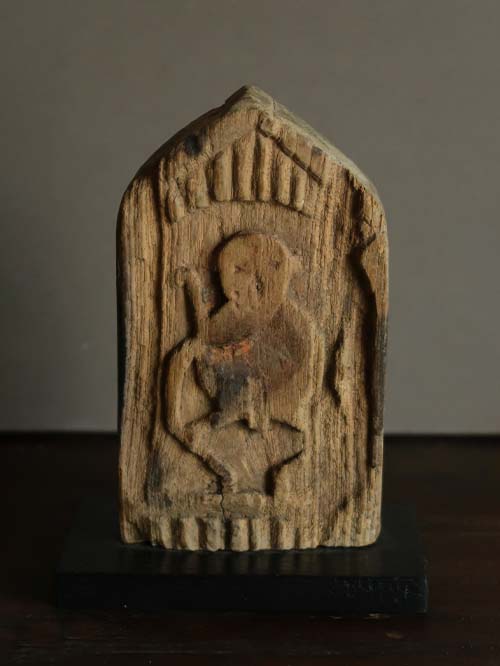
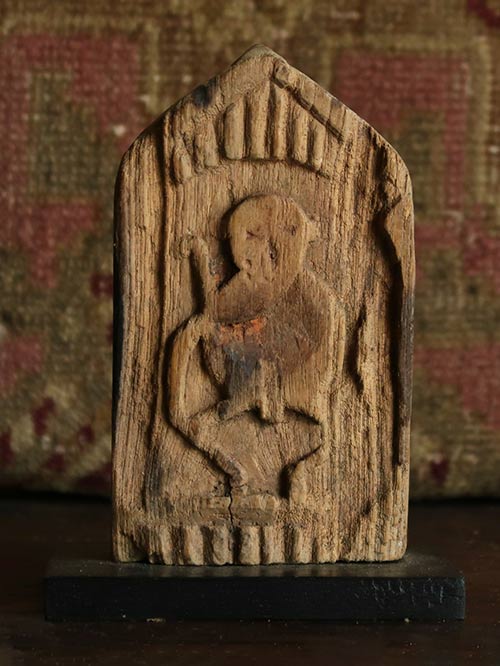
Western India
Wood
A primitive door panel with a central figure of a two-armed Ganesha. An arch frames the central figure forming a ritual throne around the deity.
Size(cms): 13.5 (H) x 10 (W) x 6.5 (D)
Size(inches): 5.3 (H) x 4 (W) x 2.5 (D)
-
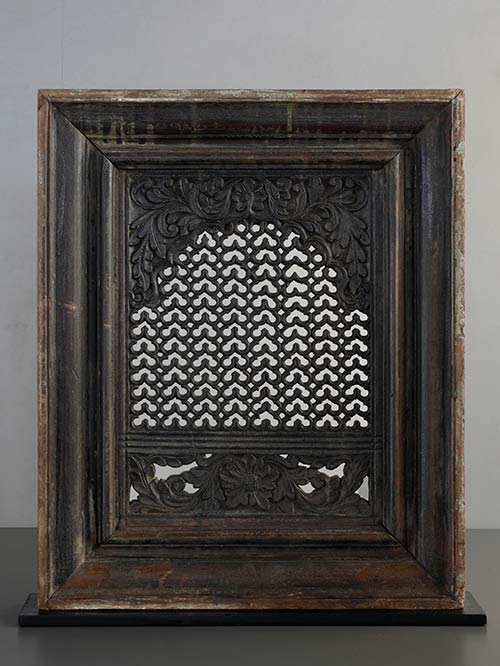

Deccan
Wood
An enchanting play of light and shadow is created from this jali or lattice window. Ideal during the hot humid Indian summer, the jalis dispel the harsh rays of the sun and allow a cool breeze to circulate indoors. Moreover, the purdah- conscious women used the jalis of their balconies and terraces to enjoy an outside view, without being seen themselves by the public.
Wooden construction was once widespread throughout most of Southern India, but the intense heat and the severe monsoonal rains have meant that a large proportion of the wooden buildings in private and public use have now disappeared. The typical southern Indian wooden building, was supported on a framework of columns, with an elaborate system of interlocking brackets and beams to support the floors and roofs. Carved doors, windows, and screens and panels filter light and ventilate the interiors, creating an environment that is both comfortable and richly detailed. The scale and shape of houses was dictated by the maximum height and span of timber beams, resulting in a modular system of construction. The woodwork was deeply cut and naturalistic, the intention of the artisans was to capture the forms and energies of the natural world.
Size (cms): 63(H) x 54(W) x 11(D)
Size (inches): 25(H) x 21.5(W) x 4.5(D)
-
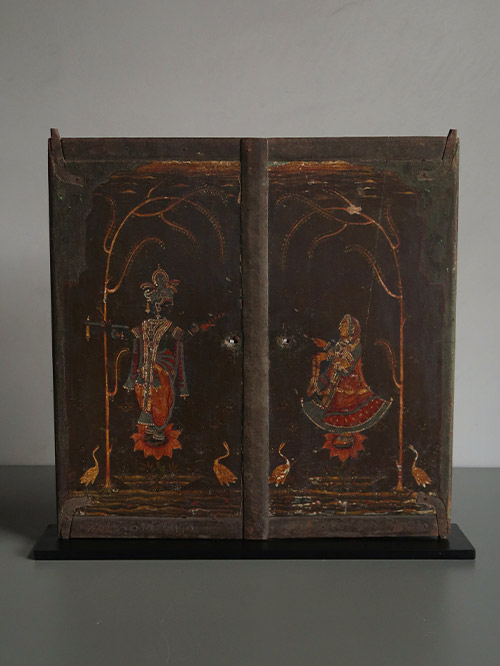
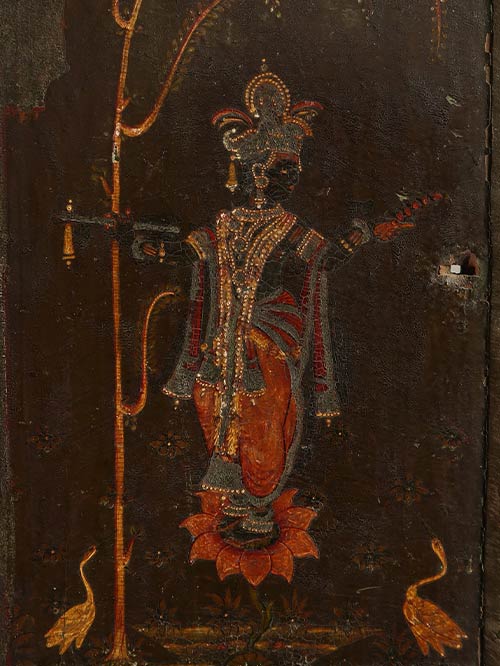
Rajasthan
Wood, polychromed
A beautiful pair of painted shutters from a household shrine. The shutter on the left depicts Krishna as Venugopala, standing on a lotus blossom upon a lake. Opposite him, Radha stands upon her own lotus, heavily bejewelled. She offers Krishna the floral garland which she holds. The nearby swans look upon the resplendent figures.
One of the most abiding images in Indian art is that of Krishna the flautist standing with his legs crossed at the ankles and playing the flute. He wears a tall decorative mukuta or crown, a dhoti and various necklaces, bangles and anklets. While other cowherders f Braj hold a shepherd’s staff, Krishna’s staff is also his flute. He, however does not play upon it to please the cows, but to charm the gopis or cowherdesses. Radha is of the Gopis of Vrindavan, who became a central figure of Vaishnava theology and she is considered to be Krishna’s favourite gopi. Radha’s selfless devotion to Krishna is regarded as a model for devotees, and she is also seen as the intermediary between man and God. According to other interpretations, Radha’s love for Krishna symbolizes the human soul’s yearning for God.
Size (cms): 51(H) x 53(W) x 10(D)
Size (inches): 20(H) x 21(W) x 4(D)
-
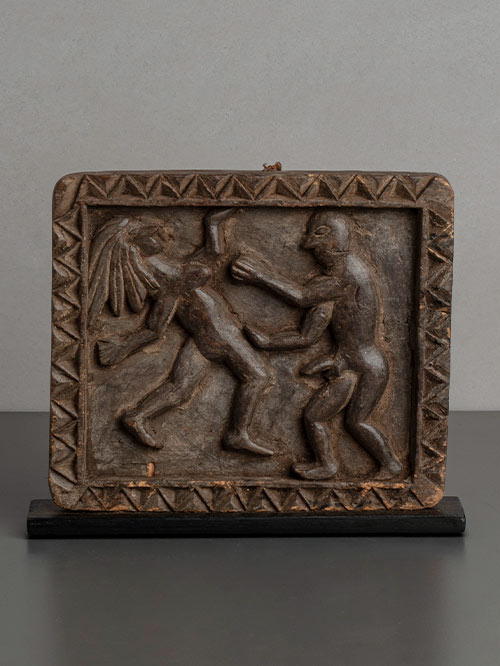
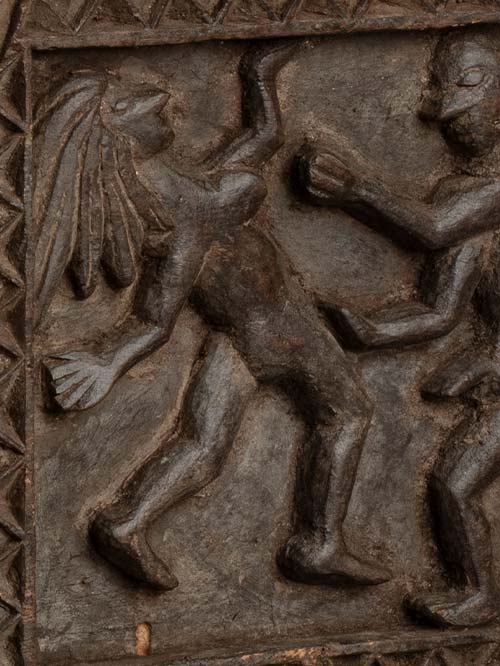
Jharkhand (Central India)
Wood
A stylised wooden panel depicting an erotic scene from the side of a Santhal Wedding Palanquin (Rahi).
The Santhals are the largest tribal community living in the Indian states of Bihar, Orissa, and West Bengal, with a minority in neighboring Bangladesh and Nepal. Marriage holds significant importance in the Santhal tribe, marked by elaborate religious and social rituals that reflect the bride and groom’s social status. A traditional aspect of the Santhal wedding ceremony involves the bride being carried in a large wicker basket or, in wealthier families, a palanquin known as a rahi.
Size (cms): 18(H) x 22(W) x 5(D)
Size (inches): 7(H) x 8.5(W) x 2(D)
-
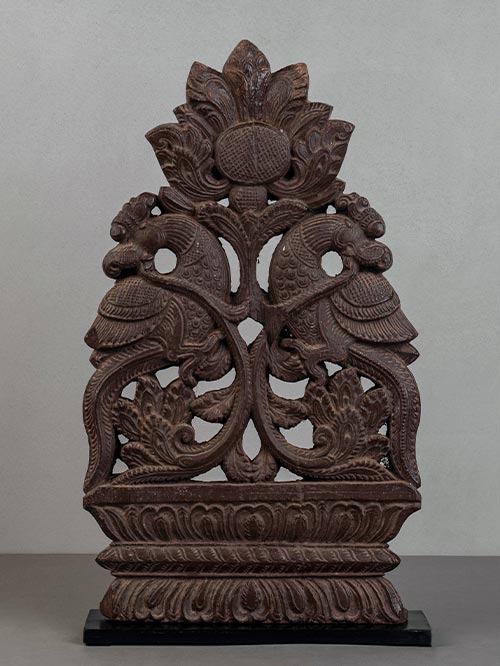
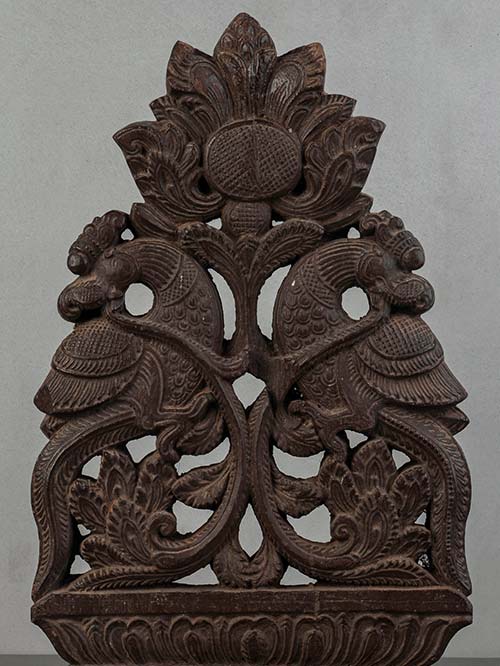
Mysore (Karnataka)
Wood
This unusual pierced panel portrays a pair of mythical Sharabhas perched atop swirling foliage, resting on a double lotus base. The mythical creatures, half-lion and half-bird, are delicately carved with scaly bodies and attractive patterned plumage. Their mouths are depicted spewing vegetation.
In Hindu mythology, Sharabha’s are a composite beast, part-lion and part-bird. Within Sanskrit literature, it initially appeared as an aggressive beast that roamed hilly and forest areas, clearing entire valley’s with a single jump. The mythological creature was later associated with Shaivism, appearing within some Puranic texts as a powerful incarnation of Shiva who assumes the form to pacify Narasimha – the fierce man-lion avatar of Vishnu worshipped by Vaishnava sect. Within Buddhist theology, Sharabha appears in Jataka Tales as a previous birth of the Buddha.
Size (cms): 50(H) x 29(W) x 9(D)
Size (inches): 19.5(H) x 11.5(W) x 3.5(D)
-
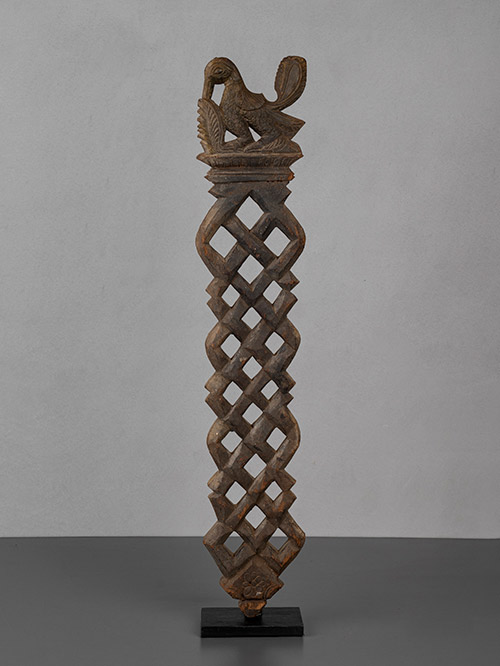

Chettinad (Tamil Nadu)
Wood
A decorative wooden spoon and ladle holder (agapai koodu) from the Chettinad region of Tamil Nadu. The knotted spoon holder has a latticed design with diamond shaped cutouts to balance the utensils. The panel is crowned with a finial depicting a hamsa bird gracefully pecking on a leafy stem
Chettinad is an area situated near the temple town of Madurai, where are large number of ornate mansions were constructed in the mid-nineteenth and early twentieth century by the Nattukottai or Nagarathar Chettiars, a traditional merchant group of traders and financiers. The Chettiars made their fortune as traders and agents of credit in Burma, Malaysia and Indonesia during the nineteenth century and returned with their profits to India, where they began constructing the elaborate mansions to proclaim their position within society. By 1945, with the rise of Nationalism through South-east Asia and looming Indian independence, the Chettiars sold their foreign interests, and returned to India to try their luck in business. As a result many of the families established new residences across the country, leaving many of their ancestral properties unused. Consequently by the 1960s and 70s, many of the Chettinad mansions, unable to raise sufficient funds for repairs, fell into decay. Many of the mansions were sold or dismantled as a result.
Size (cms): 71(H) x 14(W) x 9(D)
Size (inches): 28(H) x 5.5(W) x 3.5(D)
-

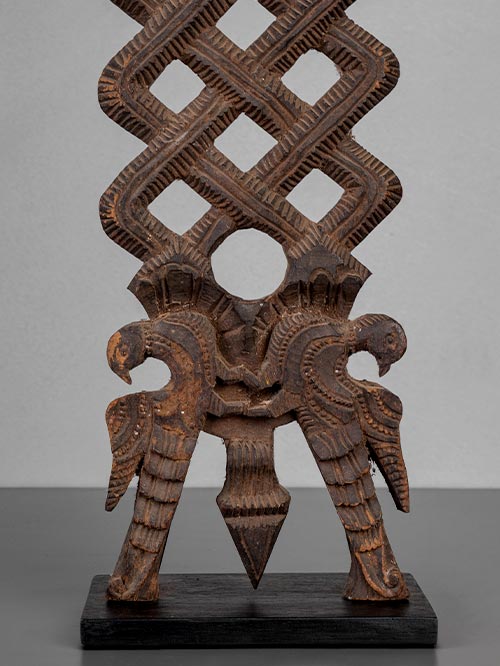
Chettinad (Tamil Nadu)
Wood
A decorative wooden spoon and ladle holder (agapai koodu) from the Chettinad region of Tamil Nadu. The knotted spoon holder has a latticed design with diamond shaped cutouts to balance the utensils. The panel is crowned with a finial shaped like a miniature temple complex, while at the bottom, a pair of parrots form an arched support.
Chettinad is an area situated near the temple town of Madurai, where are large number of ornate mansions were constructed in the mid-nineteenth and early twentieth century by the Nattukottai or Nagarathar Chettiars, a traditional merchant group of traders and financiers. The Chettiars made their fortune as traders and agents of credit in Burma, Malaysia and Indonesia during the nineteenth century and returned with their profits to India, where they began constructing the elaborate mansions to proclaim their position within society. By 1945, with the rise of Nationalism through South-east Asia and looming Indian independence, the Chettiars sold their foreign interests, and returned to India to try their luck in business. As a result many of the families established new residences across the country, leaving many of their ancestral properties unused. Consequently by the 1960s and 70s, many of the Chettinad mansions, unable to raise sufficient funds for repairs, fell into decay. Many of the mansions were sold or dismantled as a result.
Size (cms): 83(H) x 16.5(W) x 11(D)
Size (inches): 32.5(H) x 6.5(W) x 4.5(D)
-
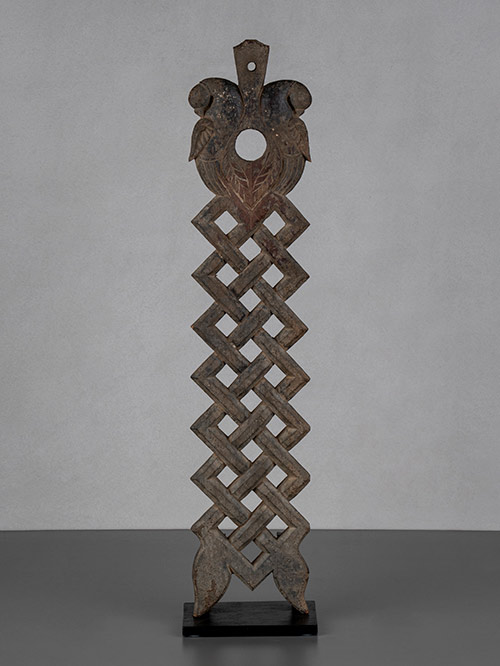
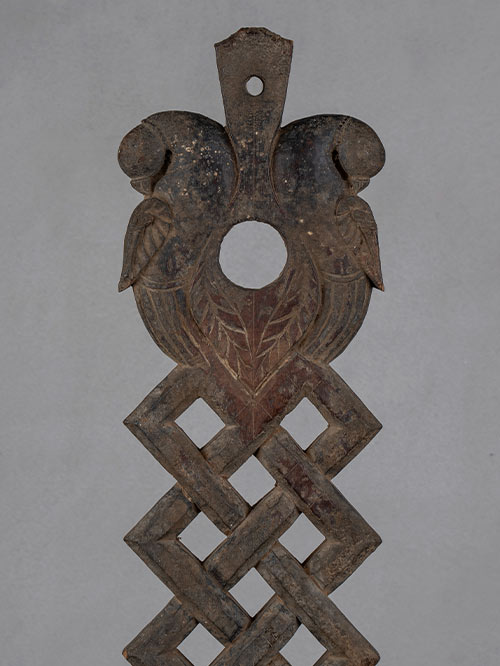
Chettinad (Tamil Nadu)
Wood
A decorative wooden spoon and ladle holder (agapai koodu) from the Chettinad region of Tamil Nadu. The knotted spoon holder has a latticed design with diamond shaped cutouts to balance the utensils. The panel is crowned with a finial depicting a pair of symmetrical parrots.
Chettinad is an area situated near the temple town of Madurai, where are large number of ornate mansions were constructed in the mid-nineteenth and early twentieth century by the Nattukottai or Nagarathar Chettiars, a traditional merchant group of traders and financiers. The Chettiars made their fortune as traders and agents of credit in Burma, Malaysia and Indonesia during the nineteenth century and returned with their profits to India, where they began constructing the elaborate mansions to proclaim their position within society. By 1945, with the rise of Nationalism through South-east Asia and looming Indian independence, the Chettiars sold their foreign interests, and returned to India to try their luck in business. As a result many of the families established new residences across the country, leaving many of their ancestral properties unused. Consequently by the 1960s and 70s, many of the Chettinad mansions, unable to raise sufficient funds for repairs, fell into decay. Many of the mansions were sold or dismantled as a result.
Size (cms): 71(H) x 16.5(W) x 12(D)
Size (inches): 28(H) x 6.5(W) x 4.5(D)
-
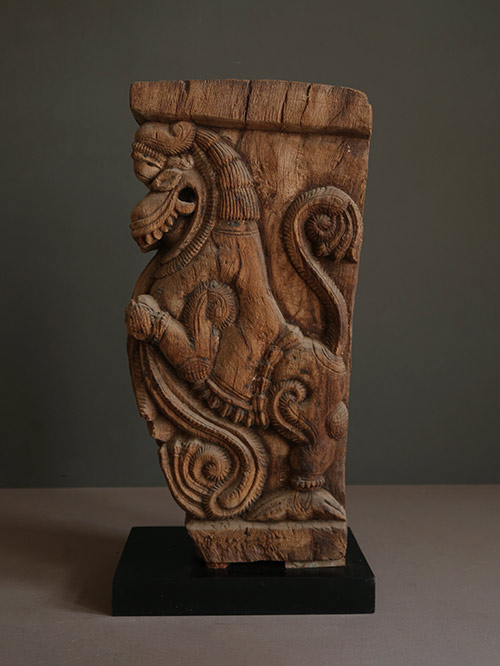

Tamil Nadu (South India)
Wood
A finely carved chariot panel depicting a fully caparisoned standing Vyali. The rearing lion is open mouthed exposing large teeth, bulging eyes and a prominent ‘sunburst’ mane. The muscular body and the torso is adorned with carved tassels. ‘Yali’ or ‘Vyala’ denotes a mythical lion faced animal that appears on carved friezes on temple walls. They are fierce, leonine beasts with curvaceous bodies and enlarged heads surrounded by flame-like manes. They rear up on hind legs, the forelegs held out with clenched claws as if to pounce. Sometimes they are shown standing on human heads presumably of the demons that they have vanquished. In southern Indian sculpture from the 16th century onwards figures of rearing, almost three dimensional vyalis bearing heads either of horned lions or elephants and feline bodies guard the entrances of temples and line the approaches leading to sanctuaries.
Size (cms): 41.5 (H) x 20 (W) x 10 (D)
Size (inches): 16.3 (H) x 7.9 (W) x 4 (D)



















